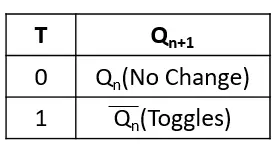Tutorials
Learn More
T Flip Flop
The T flip flop has single input as a ‘T’. Whenever input T=1, the output toggles from its previous state else the output remains the same as its previous state. It behaves the same as JK flip flop when J=1 and K=1. Hence, it can also be implemented by tieing both inputs (J and K) of JK flip flop.
Block Diagram

Truth Table

T Flip Flop Verilog Code
module T_flipflop (
input clk, rst_n,
input t,
output reg q,
output q_bar
);
// always@(posedge clk or negedge rst_n) // for asynchronous reset
always@(posedge clk) begin // for synchronous reset
if(!rst_n) q <= 0;
else begin
q <= (t?~q:q);
end
end
assign q_bar = ~q;
endmoduleTestbench Code
module tb;
reg clk, rst_n;
reg t;
wire q, q_bar;
T_flipflop dff(clk, rst_n, t, q, q_bar);
always #2 clk = ~clk;
initial begin
clk = 0; rst_n = 0;
$display("Reset=%b --> q=%b, q_bar=%b", rst_n, q, q_bar);
#3 rst_n = 1;
$display("Reset=%b --> q=%b, q_bar=%b", rst_n, q, q_bar);
drive(0); // Same as previous output
drive(1); // Toggles previous output
drive(1); // Toggles previous output
drive(1); // Toggles previous output
drive(0); // Same as previous output
#5;
$finish;
end
task drive(bit ip);
@(posedge clk);
t = ip;
#1 $display("t=%b --> q=%b, q_bar=%b",t, q, q_bar);
endtask
initial begin
$dumpfile("dump.vcd");
$dumpvars(1);
end
endmoduleOutput:
Reset=0 --> q=x, q_bar=x
Reset=1 --> q=0, q_bar=1
t=0 --> q=0, q_bar=1
t=1 --> q=1, q_bar=0
t=1 --> q=0, q_bar=1
t=1 --> q=1, q_bar=0
t=0 --> q=1, q_bar=0Verilog Codes